|
Printables |
PowerPoints |
Online exercises |
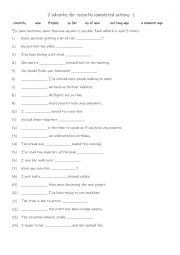
|
7 adverbs for recently completed actions 1
First, students need to familiarise themselves with the 7 adverbs. Then they read the sentences to work out which one is needed to complete the gap-fill. Each adverb is used 3 times! Answers on page 2
Level: elementary
Age: 9-100
Type:
Downloads: 120
|
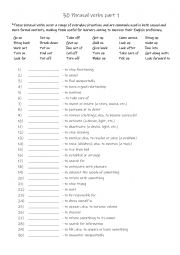
|
30 Phrasal verbs part 1 a
These phrasal verbs cover a range of everyday situations and are commonly used in both casual and more formal contexts, making them useful for learners aiming to improve their English proficiency; they are suitable for CEFR A2-B1 levels. Students match the phrasal verbs to their definitions. Answers on page 2. All of the phrasal verbs used in this ...
Level: elementary
Age: 10-100
Type:
Downloads: 119
|
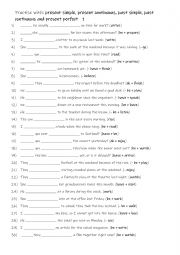
|
A2-B1 Practise with: present simple, present continuous, past simple, past continuous and present perfect 1
Students at the A2-B1 level should practise the present simple, present continuous, past simple, past continuous, and present perfect tenses as they form the foundation of clear and effective communication. These tenses enable learners to discuss routines, habits, and facts, describe ongoing actions, recount past events, and share experiences or ac...
Level: intermediate
Age: 9-100
Type:
Downloads: 120
|
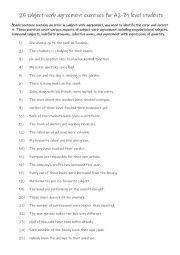
|
25 subject-verb agreement exercises for A2-B1 level students
Each sentence contains an error in subject-verb agreement, students need to identify the error and correct it. These exercises cover various aspects of subject-verb agreement, including singular/plural subjects, compound subjects, indefinite pronouns, collective nouns, and agreement with expressions of quantity. Answers on page 2
Level: elementary
Age: 10-100
Type:
Downloads: 107
|
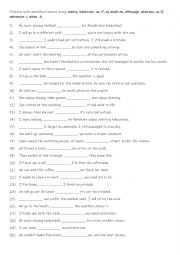
|
A2+-B1 Adverbial clauses 4
Learning adverbial clauses using words like unless, wherever, as, if, as much as, although, whereas, as if, whenever and when helps students express complex relationships between ideas, such as condition, time, contrast, and manner. First, students need to familiarise themselves with the 10 adverbial clauses and their use. Then they read the senten...
Level: intermediate
Age: 10-100
Type:
Downloads: 118
|
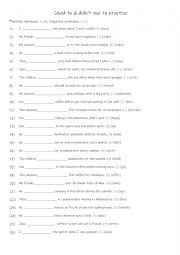
|
A2+-B1+ Used to & didn�t used to
Students complete the sentences using the given verbs. Positive sentences = (+). Negative sentences = (-). There are 13 positive and 13 negative sentences. Answers on page 2.
Level: elementary
Age: 8-100
Type:
Downloads: 129
|
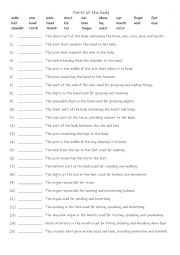
|
A1+-A2 25 parts of the body definitions
Learning these 25 body parts and their definitions is helpful for basic communication about health and daily activities. Knowing the names of body parts allows students to explain how they feel, describe symptoms to doctors, and understand instructions related to movement or health care. These words are also common in simple conversations and expre...
Level: elementary
Age: 8-100
Type:
Downloads: 117
|
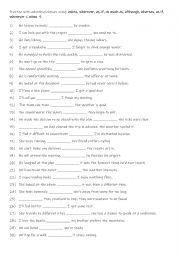
|
Practise with adverbial clauses using: unless, wherever, as, if, as much as, although, whereas, as if, whenever & when 5
Learning adverbial clauses using words like unless, wherever, as, if, as much as, although, whereas, as if, whenever and when helps students express complex relationships between ideas, such as condition, time, contrast, and manner. First, students need to familiarise themselves with the 10 adverbial clauses and their use. Then they read the senten...
Level: intermediate
Age: 10-100
Type:
Downloads: 100
|
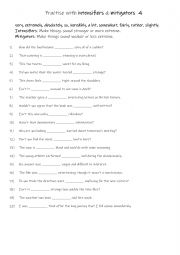
|
B1-B2 Practise with intensifiers & mitigators 4
First, students need to familiarise themselves with the intensifiers & mitigators and their use. Then they read the sentences to work out which one is needed to complete the gap-fill. Each intensifier & mitigator is used 2 times! Obviously, there are more than 1 possible answer! Possible answers on page 2
Level: intermediate
Age: 11-100
Type:
Downloads: 124
|
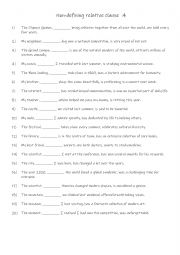
|
Non-defining relative clause 4
Students complete the gap-fill with the correct word. Answers on page 2.
Level: elementary
Age: 8-100
Type:
Downloads: 112
|
|
|
|
|












